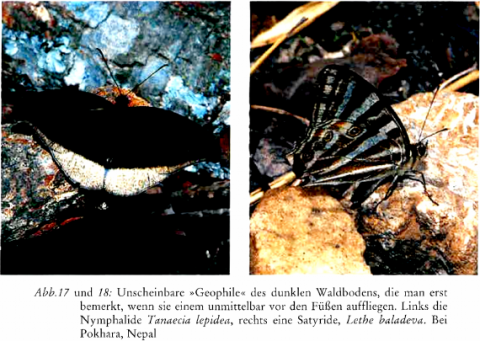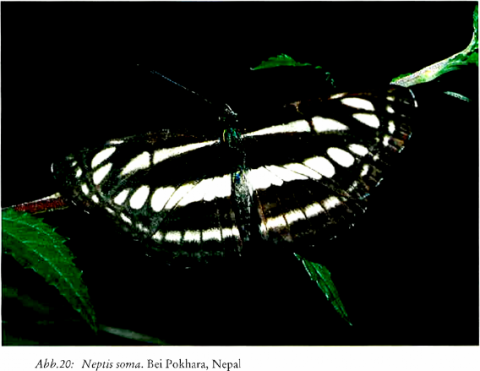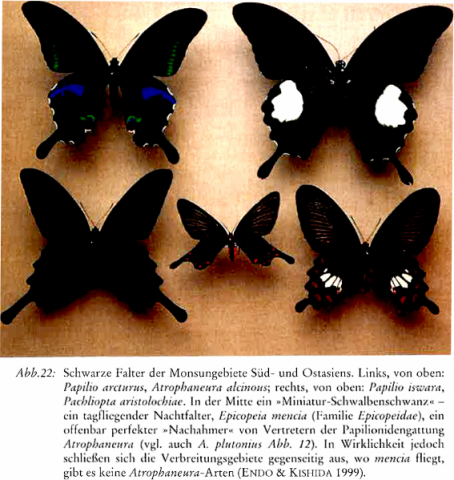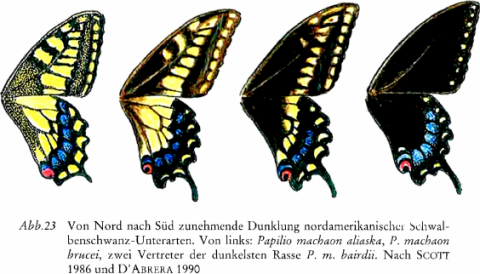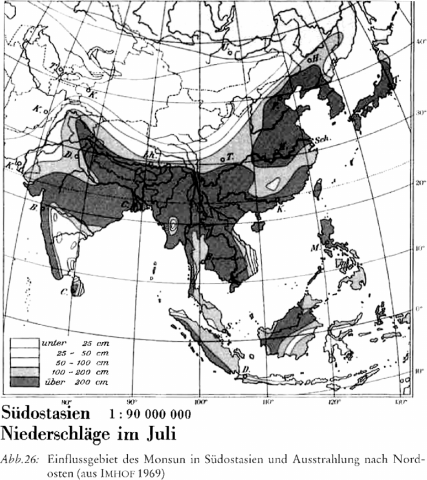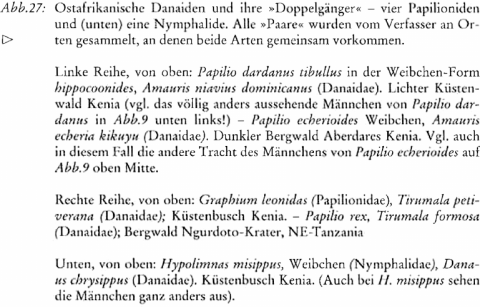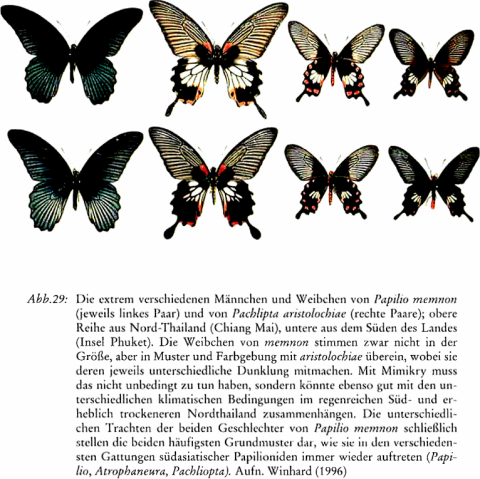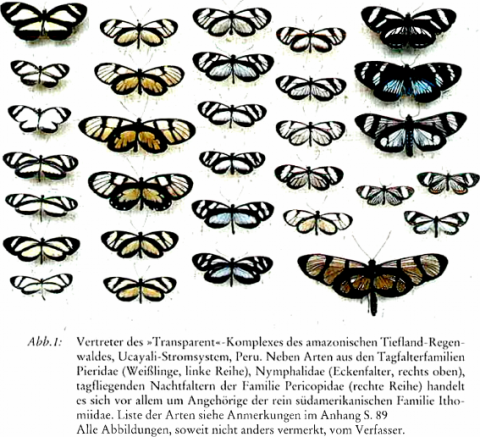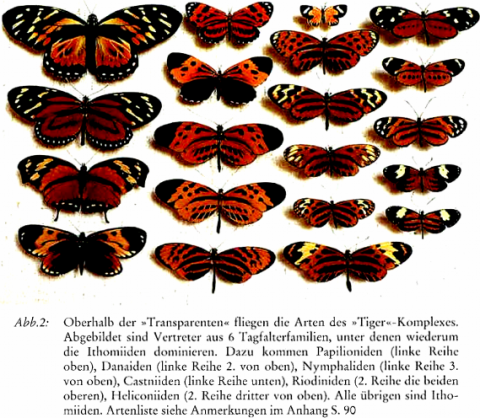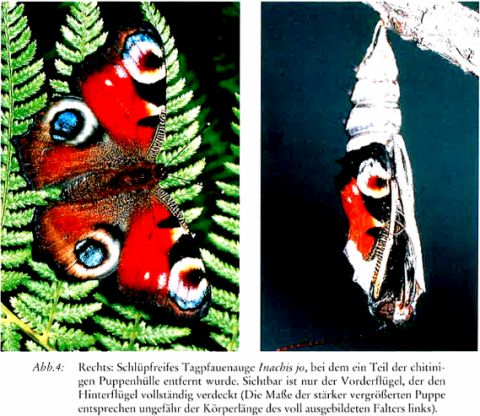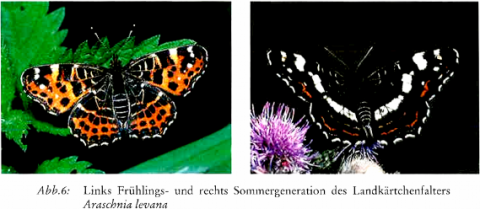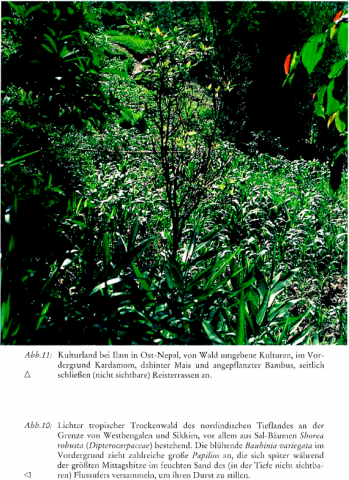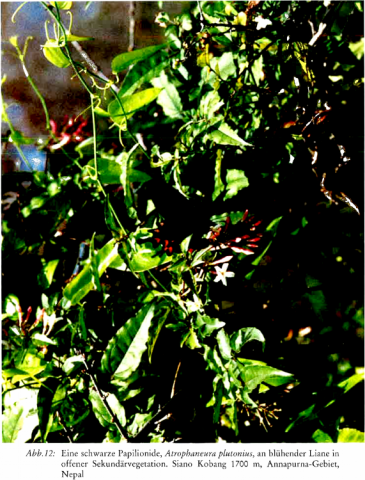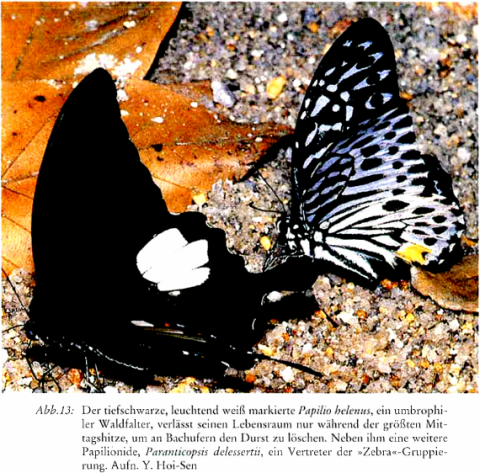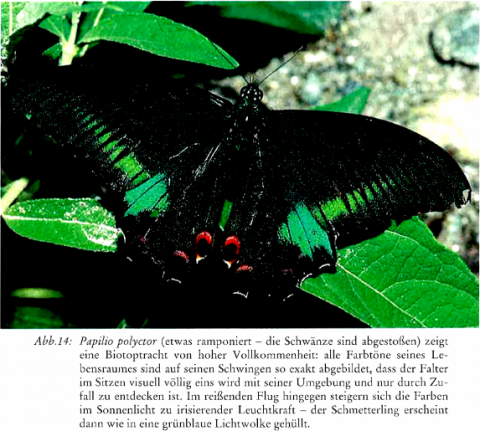Über den Zusammenhang von Biotoptracht und Mimikry bei Schmetterlingen
Beobachtungen in Südasien und anderen Kontinenten
Export Article Citation as
- Download price : €6
Abstract:
Wing pattern; ofbutterflies (Lepidoptem) as mirrors ofenvironmental colours and light
Research in the tropics of the southern continents as well as in the temperate regions during the last decades has reve.tled the intimate correlatiun of wing colourstion and Wing pattern in butterflies with the corresponding features of their respective environments. 'l'herefnre the author introdtie'ed the term -hiotope pnttern- (»Biotoptrachh). For -a long time the discussion in this field has been exclusively dominated by the theory of "l'nlmict'yfi: the protection against predators - which is achieved through the»av.iaptations«to the environment - is hehe-ved to be the cause of their evolution «mr! $]’7'L'rtd. Random mutations are supposed to have given rise to mugh similarities which are then honed hy natural selection. This assttmption is not very convincing because random mutations hy definition contradict to the high degree. of synorg-anisation of a multitude of anatomical und physiologia.ial details Working together in building up the definitive Wing pattern.
A more holistic concept avoids the dualistic (and atomis1ic) approach (organisms and environment seen as entirer different entities) and tries to understaml organisms on the one hand as independent heings, on the other hand englohed. formed ‘.tttd structttred by the supet'organism of the ecosystem in which they live. What is lmppening in one aspect. is also present in the other: the organism is receptive to the multitude of influences from the sem-called environment, which in turn is influenced and formed by the organisms which inhabit it. Both directions are cle.trly visible in the ontogenetic development of the wing pattern of hutterflies. which is achieved in two suhsequent steps: at first serial stripes are formed. spreatding in it centrifugal manner from certain»nuclei«in the epidermal layer of the wings. In a second step these primary structures are transformed in the majority of cases in a way that the elements of the forewing and hindwing form an entity, fitting together even in minor details (»integrated pattern", -Totalzeichnung-). This second step of creating the definite colotn‘s anti patterns takes place in the first 43 hours after pup.ttion‚ teben tbe demrlnpt'ttg tet'ngs „re tto7ied [nude mu from their v‚ttm'kets«in the farm! body am! sprend our «long the outside. It is most astonishine, that the wings - separate structures of septtrate segtnents of the body, which in the fully developped hutterflv are held juxtaposed. one in front of the other - are supertmpused during their pupal development, the forewing covering entircly the hindwing (separated by a thin chitinous layer). Yet the patterns are formed in v;tlltiL'ip:tlhtlt-t of their final side-hy-side position! It is ohvious that the formation of the pattern is rttled by two antagonistic inl'luv ences: the first is directed hy the organistn itself, the second, integrating the formedy isolated p.ttterns into a whole, is related to the struetures of the environment - in which the hutterflv is an integrated part. an organ , fornting the «biotope pattern-.
This does not mean a step back from Darwin to l.1marck. Both eonsecutive stages are genetically fixed and cannot be ;tltered from one generation to the other hy simply changing the environment. But it seems to be possible by Irmg-term t"h{tflj_(t'5 of the environmental conditions as seen in the evolution of well adapted animals during longterm elimatie changes (e. g. ice age). But it may even happen in a relatively short time and during only a few generations. This is shown hy the appearanee of «mullilude of entirely new forms after transfer of the wild progenitors in a totally new environment during domestication, giving rise to countless forms which never before existed in the wild. A certain confirmation of this view could perh-aps be seen in recent findings that in highly deversified and intergrading ecosystems (ecotones) a companth high geno- and phenotypic diversity is to be found, whereas great uniformity reigns in large-scale habitats. As with changes in time. differences in space «when individuals of the same species occupy different habitats - seem to have a related niicfit'0evolutionary effeet.
References
- ACKERY, P.R. & VANE-WRIGHT, R. I. (1984): Milkweed Butterflies. Their Cladistics and Biology. London (Brit. Museum, Nat. Hist.)
- AN DER HEIDEN, U. (1991): Der Organismus als selbstherstellendes dynamisches System: In: Zänkert, K. S. (Hrsg.), Kommunikationsnetzwerke im Körper. Heidelberg
- AN DER HEIDEN, U., Rom, G. & SCHWEGLER, G. (1985): Die Organisation der Organismen. Selbstherstellung und Selbsterhaltung. Punkt. Biol. Med. 5: 330346
- ASAHI, J., KANDA, S., KAWATA, M. & KOHARA, Y. (1999): The Butterflies of Sakhalin in Nature. Tokyo.
- BARKAI, N. & LEIBLER , S. (1999): Ultrasonic hearing in nocturnal butterflies. Nature 403: 265-268
- BATES, H. W. (1862): Contributions to an insect fauna of the Amazon valley. Transactions of the Linnean Society London 23: 495-566
- BEUTLER, A. (1996): Die Großtierfauna Europas und ihr Einfluss auf Vegetation und Landschaft. In: Gerken, B. & Meyer, C. (Hrsg.), Wo lebten Pflanzen und Tiere in der Naturlandschaft und der frühen Kulturlandschaft Europas? Natur- und Kulturlandschaft 1: 51-106
- BOCKEMÜHL, J. (1966): Bildebewegungen im Laubblattbereich höherer Pflanzen. Elemente der Naturwissenschaft 4: 7-23. Abgedrucltt in: Schad, W. (Hrsg.), Goetheanistische Naturwissensehadt Bd. 2 (Botanik). Stuttgart 1982
- BOCKEMÜHL, J. (1967): Äußerungen des Zeitleibes in den Bildebewgungen der Pflanze. Elemente der Naturwissenschaft 7: 25 30. Abgedruckt in: Schad, W. (Hrsg.), Goetheanistische Naturwissenschaft Bd. 2 (Botanik). Stuttgart 1982
- BÖHME, G. (1993): Am Ende des Baconschen Zeitalters. Studien zur Wissenschaft& entwicklung. Frankfurt/M.
- BOPPRE, M. (1977): Phemmonbiologie am Beispiel der Monarchfalter (Damaia'ae). Biologie in unserer Zeit 7(6): 161-169
- BOPPRE, M. (1982): Cemically Mediated Interactions Between Butterflies. In: Vane-Wright, R. I. & Ackery, P. R. (Ed.), The Biology of Butterflies. Symposium of the Royal Entomological Society of London 11: 259-275
- BOPPRE, M. (1995): Pharmakophagie: Drogen, Sex und Schmetterlinge. Biologie in unserer Zeit 25(2): 8-17
- BROWER, L. P. (1969): Ecological Chemistry. Scientific American 217(2): 22-29
- BROWER, L. P. (1984): Chemical Defence in Butterflies. In: VaneWright, R. I. & Ackery, P. R. (Ed.), The Biology of Butterflies. Symposium of the Royal Entomological Sof ciety of London 11: 109-134
- BROWN, K. S. (1999): Life on the edge. New Scientist 164(2213): 47-49
- CALVERT‚ W. H., HEDRICK‚ L. E. & BROWIER, L. P. (1979): Mortality of the Monarch butterfly (Dmmus plexippz4s) due to avian predation at five overwintering sites in Mexico. Science 204: 847-851
- CARCASSON, R. H. (1960): The Swallowtail Butterflies of East Africa (Lepidoptem, Papilionidae). journal of the East African Natural History Society, Special Suppl
- CARCASSON, R. H. (1963): The MilkWeed Butterflies of East Africa (Lepidoptem, Danaidae}. Journal of the East African Natural History Society 24(2): 19-23
- CHAI, P. (1986): Field observations and feeding experiments on the responses of rulous»tailed jacatnatrs (Ga/171114 rnjicanda) to frtellyitig hutterflies in a tropical rainforest. Biolocienl journal of the Linnean Society of London 29: |61-l89
- CHAI, P. (1996): Butterfly visual characteristics and ontogeny of responses to butterflies hy & speciali7.cd tropical hird. Biological Journal of the Linnean Society of London 59: 37-67
- CLARKE‚ C. A. & SHEPPARD P. M. (1963): lnteractions between major genes and pt'ilygcnes in the determination of the mimetic patterns of Papilio dan/an;»;s. Evolution 17(4): 404-413
- CORBET, A. S. & PENDLEBURY, H. M. (1992): The Butterflies of the Malay Peninsula. 4th ed. Rev. By J. N. Eliot. Kuala Lumpur
- D’ABRERA, B. (198l-1994): Butterflies of the Neotropical Region Part I-VI. Melbourne, Victoria
- D’ABRERA, B. (1982-1986): Butterflies of the Oriental Region Part I-III. Victoria
- D’ABRERA, B. (199-1993): Butterflies of the Holarctic Region Part I-III. Victoria
- D’ABRERA, B. (1997): Butterflies of the Afrotropical Region Part I. Revised Ed. Victoria
- DAWKINS, R. (1976): The Selfish Gene. Oxford
- DOBREMEZ, J.-F. (1976): Le Népal - Ecologie et Biogéographie. Ed. Centre Nat. Rech. Sci. Paris
- EBERT, G. & RENNWALD, E. (1991): Die Schmetterlinge Baden-Württembergs Bd. 1. Stuttgart
- ENDO, T. 8: KISHIDA. Y. (l999): Day-Flying Moths Chalcosiinae‚ Epicopez'a. Endless Science Information Vol. 8, Tokyo
- GIBSON, D.O. (1934): How is Automimikry Maintained? In: Vane-Wrigltt, R. I. & Ackery, P. R. (Ed.), The Biology of Butterflies. Syposium of the Royal Entomological Society of London 11: 163-165
- GUT, B. J. (1968): Zur Theorie der Gestalterkenntnis. Elemente der Naturwissenschaft 9: 1-19
- HARTMANN, N. (1958): Philosophische Grundfragen der Biologie. Kleinere Schriften Bd. III. Berlin
- HEIKERTINGER, F. (1954): Das Rätsel tler Mimiltry und seine Lösung. Jena
- HENKE, R. (1948): Einfache Grundvorgänge in der tierischen Entwicklung II: Über die Entstehung von Dilfcrenziernngsmustern. Naturwissenschaftcn 35: 176181, 203 211, 239-246
- HENKE, R. & KRUSE, G. (1941): Über Feldgliederungsmuster bei Geometriden und Noetuiden und den Musterbauplan der Schmetterlinge im allgemeinen. Nachr. Akad. Wiss. Göttingen Math.-Phys.Klassez 133-l9.
- HESSELBARTH, G., van OORSHOT‚ H. & WAGENER, S. (1995): Die Tagfalter der Türkei unter Berücksichtigung der angrenzenden Länder. Bocholt
- HOLDREGE, C. (1999): Science as progress or dogma? Elemente der Naturwissenschalt 70/1: 39-51
- HOLLOWAY, J. D. (1974): The Biogeography of Indian Butterflies. In: Mani, M. S. (Ed.), Ecology and Biogeography in India. Den Haag
- HUBER, G. (1981): Philosophische Fragen zum Darwinismus. Vierteljahresschrift der Naturforschcntlen Gesellschaft, Zürich 126(1): 3-17
- IGARASHI, S. & FUKUDA, H. (1997): The Life History of Asian Butterflies Vol. 1. Tokyo
- IMHOF, E. (1969): Schweizerischer Mittelschulatlas. Lehrmittelverlag des Kantons Zürich, 5. 85. Zürich
- KETILEWELL, H. D. B. (1955): Selection experiments on industrial melanism in the Lepidoptera. Heredity 9: 323-342
- KOEPCKE, H.-W. (1973): Die Lebensformen Bd. 1. Krefeld
- KOMAREK, S. (1989): Vorkommen, Morphologie und Evolution der Augenmuster in der I‘lügelzeiclmung der Familie .S'pbingidae. Zonlogische Jahrbücher, Abteilung für Systematik. Ökologie und Geographie der Tiere 116: 217-254
- KOMAREK, S. (1998): Mimicry, Aposematism anal Related Phenomena in Animals and Plants. Bibliography 1800-1990. Prag
- KNYSTAUSTAS, A. (1987): The Natural History of the USSR. London
- KNYSTAUSTAS, A. & SIBNEV, J. B. (1987): Die Vogelwelt Ussuriens. Hamburg, Berlin
- LAUER, W. (1975): Vom Wesen der Tropen. Klimaökologische Studien zum Inhalt und zur Abgrenzung eines irdischen Landschaftsgürtels. Akad. Wiss. Lit. Mainz, Abb. Math.-Nat. Klasse 3. Mainz
- LEWONTIN, R. C. (1992): The Dream of the Human Genome. The New York Review of Books 39(10): 31-40
- LEWONTIN, R. C. (1993): The Doctrine of DNA. Biology as Ideology. London
- MALCOLM, S. & ROTHSCHILD, M. (1983): A danaine mullerian mimic, Exploea core amyome (Cramer) lacking cardenolides in the pupal and adult stage. Biological journal of the Linnean Society of London 19: 27-33
- MALLET, J. & GILBERT; L. E. Jr. (1995): Why are there so many mimicry rings? Correlations between habitat, behaviour and mimicry in Heliconiz»ts lml‘lerflies. Biological Journal of the Linnean Society of London 55: 159-180
- MANI, M. S. (1986): Butterflies of the Himalaya. Dordrecht, London
- MÜLLER, F. (1878): Über die Vortheile der Mimicry bei Schmetterlingen. Zoologischer Anzeiger 1: 54-55
- NAHRSTEDT, A. (1988): Flachs, Hornklee, Widderchen und Blausäure. Cyanogenese in Schmetterlingen. Biologie in unserer Zeit 18(4): 105-109
- NIJHOUT, F. H. (1981): The color patterns of butterflies and moths. Scientific American 254(5): 145-151 (deutsch: Geheimnisvolle Schmetterlingsmuster. Spektrum der Wissenschaft 1: 32-40, 1982)
- OUDEMANS, J. T. (1903): Etude sur la position de repos chez les Lépidoptéres. Verh. Konigl. Akad. Wetensch. Amsterdam 10, H. Section No. 1
- PAPAGEORGIS, C. (1974): The Adaptive Significance of Wing Coloration in Mimetic Neotropical Butterllies. Dissertation Princeton University
- PAPAGEORGIS, C. (1975): Mimiery in Neutropieal butterflies - why are there so many complexes in one place? American Scientist 63(5): 522-532
- PINRATANA, A. (1977): Butterflies in Thailand Vol. 1. Revised Ed. Bangkok
- PORTMANN, A. (1956): Tarnung im Tierreich. Berlin, Göttingen, Heidelberg
- PORTMANN, A. (1965): Die Tiergestalt. 2.Aufl. Freiburg, Basel, Wien
- PORTMANN, A. (1976): Einführung in die vergleichende Morphologie der Wirbeltiere. 5.Aufl. Basel, Stuttgart
- REMANE, A. (1950): Ordnungsformen der lebenden Natur. Studium Generale 3: 404-410
- REMANE, A. (1957): Offene Probleme der Evolution. Nova Acta leopoldiua 42(218): 165-170.
- REMANE, A., STORCH, V. & WELESCH, U. (1957): Evolution. Tatsachen und Probleme der Abstammungslehre. München
- REMMERT, H. (1989): Ökologie. 4. Aufl. Berlin, Heidelberg, New York
- ROBBINS, R. K., LAMAS, G., MIELKE, O. H. H., HARVEY, D. J. & CASAGRANDE, M. M. (1996): Taxonomic Composition and Ecological Structure of the SpeciesRich Butterfly Community at I‘.|l<itza. Parque Nacional del Manu, Perti. In: Wilson, D. li. &: Santloval‚ A. (Ed.), Manu - The Biotliversity of Southeastern Peru/ La Biodiversidad del Sureste del l’cr|i. Lima
- ROESLER, R.U. & KÜPPERS, P.V. (1977): Beiträge zur Kenntnis der Insektenfauna Sumatras Teil 6: Betrachtung zum Problemkreis »Mimikrv«am Beispiel s||(lostasiatiseher Insekten Beiträge 7.tu |||t|||l|t|||dli('hü| Iorsehung ||| Südwestdeutschland 36: 1 13-151
- SCHAD‚ W. (1971): Säugetiere und Mensch. Zur Gestaltbiologie vom Gesichtspunkt der Dreigliederung. Stuttgart
- SCHAD‚ W. (1992): Das Nervensystem und die übersinnliehe Organisation des Menschen. In: S('h.|(l‚ W. ([ Irsg.)‚ Die menschliche Nervenorganisation und die soziale Frage Bd. 1. Stuttgart
- SCHAD‚ W. (1993): Fliegende Feuer und verschattete Falter in Nordamerika. Tycho de BraheJahrbuch für Goetheanismus 1993. NielerwÖschelhronn
- SCHNEIDER, C. & MORITZ, C. (1999): Rainlorest Relugia and Evolution in Australia’s Wet Tropics. Proceedings of the Royal Society of London 11 266: 191
- SCHWEINFURTH, U. (1957): Die horizontale und vertikale Verbreitung der Vegetation im Himalaya. Bonner geographische Al.|l|;|||dlt|||gü| Heft 20. Bonn
- SCOTT ( 1986): The Butterflies of North Anwrica. Stanford
- SEITZ, A. (1911): Die Großsehmetterlinge der Erde. Afrikanische Tagfalter. Stuttgart
- SEITZ, A. (1933): Die Großschmetterlinge der Erde. Indo-Australisehe Fauna: Schwärmer und Spinner. Stuttgart.
- SEITZ, A. (1924): Die Großschmetterlinge der Erde. Amerikanische Tagfalter. Stuttgart
- SHAPIRO, A. M. (1977): Avian prcdation on butterflies - again. Entom. Rec. and journ. of Variation 89: 293295. London
- SMITH C. (1989): Butterflies of Nepal. Bangkok
- SMITH C. (1993): Illustrated Checklist of Nepal's Butterflies. Lashkar (Indien)
- SPARKS J. ( 1:993) Im Reich des Russischen Bären. Eine Naturgeschichte Russlands und (1(|e zent|'alasiatisehen Republiken.2 .Aufl. Köln
- SUCHANTKE A. (1974): Biotoptracht und Mimikry bei afrikanischen Tagfaltern. Elemente der Natur-wissenschaft 21: 1-21. Ahgedruckt in: Sehad. \V. (Hrsg.), GoctheanistischeN Namrwissm.schaft Bd. 3 (Zoologie). Stuttgtrt 1983
- SUCHANTKE A. (1976a): Biotopnacht bei südamerikanischen Sclnncttmlingen. I: 1emente der Nattlrw isscnschalt 25: 1-.8 Abgcdruelst |||: Sch-ad \\‘/ (1"‚1|'sg.) Goe|lmahisdselu Naturwissenschah Bd. } ('/oologie) Stuttgart 1933
- SUCHANTKE A. (1976b): Die Buckelzirpen (Men:bracidae) und die I"or|nensprache der Insekten. Elemente der Naturwissensehalt 24: 1-14. Abgedruekl in: Schad, W. (Hrsg.), ($oetheani.stische N.|tunvissensehaft Bd. 3(7(|01ogi&) Stuttgtrt 1983
- SUCHANTKE A. (1982): Der Kontinem der Kolibris. Landschaften und Lebensformen in den Iropen Südamerikas. Stuttgart
- SUCHANTKE A. (1989): Die Mutations- und Selektionstheorie in der Konfrontation mit der Wirklichkeit. In: Arnold, H. (Hrsg.), Entwicklung. Interdisziplinäre Aspekte zur Evolutionsfrage. Stuttgart
- SUCHANTKE A. (1991): Der Schmetterling in der Landschaft. Biotoptrachten europäischer '1'agfalter, verglkhen mit den Verhältni5sm ||| tropisdwn Breiten. 'l ycho de BraheJahrhuch für Gouheanimmm 1991. N|(f(‘| || -Oschell|ronn
- SUCHANTKE A. (1993): Partnerschaft mit der Natur Entscheidung für das kommende Jahrtausend. Stuttgart
- SUCHANTKE A. (1997): Kritische Anmerkungen usw. In: Gerken, B. & Meyer, C. (Hrsg.), Vom Waldessaum zur Hecke - Geschichte, Situation und Perspektiven eines NaturLebensraum-Gefüges. Natur- und Kulturlandschaft 2: 245-247
- SUCHANTKE A. (1998a): Begegnung mit »Cobra-Lilies« im Himalaya und Blick auf die Familie der Aracccn. Tycho de Brahc-jahrbuch für Goetlwanisrnus 1998. Nicfern-Öschelbronn
- SUCHANTKE A. (1998b): Der ökologische Organismus. In: Suchantke, A. (Hrsg.), Goetheanistische Naturwissenschaft Bd. 5 (Ökologie). Stuttgart
- SÜFFERT, F. (1932): Phänomene visueller Anpassung. Zeitschrift für Morphologie und Ökologie der Tiere 26: 147-316
- TISCHLER, W. (1984): Einführung in die Ökologie. 3. Aufl. Stuttgart
- TROLL‚ C. (1959): Zur Physiognomik der Tropcngewiichse. Jahresber. Ges. Freunde u. Förderer d. Universität Bonn für 1958. Bonn
- URQUHART, F. A. (1960): The Monarch Butterfly. Toronto
- URQUHART, F. A. (1976): Found at Last: The Monarch’s Winter Home. National Geographic 150(2): 160-173
- WALTER, H. & BRECKLE, S.-W. (1991): Ökologie der Erde Band 4: Gemäßigte und Arktische Zonen außerhalb Euro-Nordasiens. Stuttgart
- VEREIJKEN, H. (1990): Beobachtungen an westeuropäischen T agfaltern. Elemente der Naturwissenschaft 53: 22-40
- VOGEL, S. (1972): Komplementarität in der Biologie und ihr anthropologischcr Hintergrund. In: Gadamcr, H.-G. & Vogler, P. (Hrsg.): Neue Anthropologie Bd. 1: Biologische Anthropologie, Erster Teil
- WEBER, H. (1954): Grundriss der Insektenkunde. 3. Aufl. Stuttgart
- WEIDEMANN, H. J. (1995): Tagfalter beobachten, bestimmen. 2. Aufl. Augsburg
- WICKLER, W. (1968): Mimikry. Nachahmung und Täuschung in der Natur. München
- WILSON, E. O. (1997): Der Wert der Vielfalt. München
- WINHARD, W. (1996): Konvergente Farbmusterentwicklungen bei Tagfaltern. Spixiana Suppl. 21
- WOODHOUSE, L. G. O. (1950): The Butterfly Fauna of Ceylon. 2nd ed. Colombo
- WYNTER-BLYTH, M. A. (1982): Butterflies of the Indian Region. Reprint 1982. New Delhi


